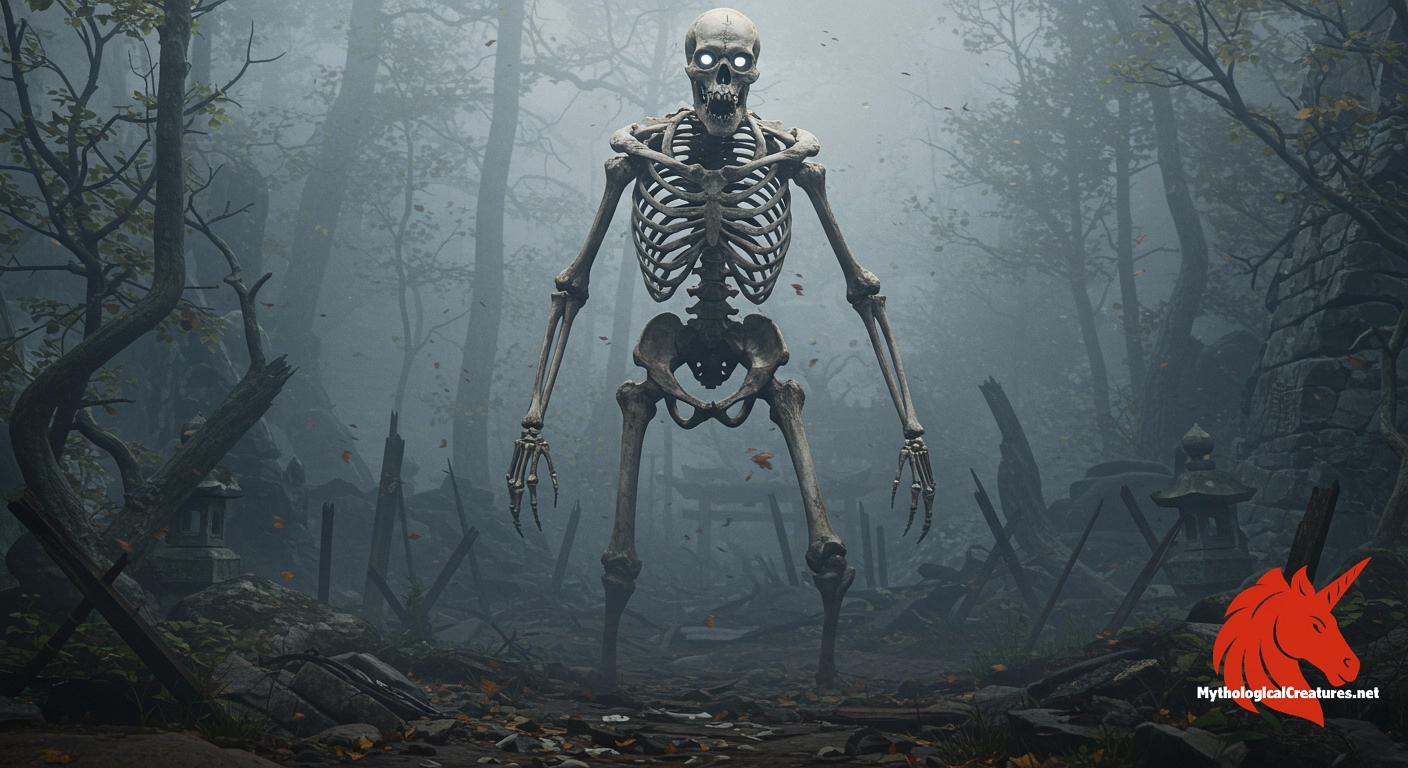Gashadokuro: Gashadokuro is a colossal skeletal apparition from Japanese mythology that roams desolate battlefields under the cover of darkness.

Gashadokuro
Gashadokuro - They serve as a grim reminder of the countless lives lost in times of war and famine, symbolizing retribution and the unsettled spirit of the dead.
Origins & First Encounters
The Gashadokuro emerges as a daunting figure within Japanese folklore, its legend echoing the collective memories of famine and lost lives. Born from the unavenged sorrow of those who died in periods of extreme hardship, the creature embodies the tragic residue of past conflict and neglect. Its very name, meaning "rattling skeleton," conjures images of a massive, restless spirit whose presence is felt as much as it is seen. The earliest whispers of its existence can be traced back to the Edo period, where oral tales captured the chilling sounds of bones clattering in the midnight air. Over time, these accounts merged with regional narratives, forming a composite myth that reflects both historical trauma and supernatural retribution. Populated by the ghosts of unburied dead, the Gashadokuro serves as a reminder that the past is never truly laid to rest. Modern reinterpretations have strengthened its role as a cultural symbol of the consequences of widespread suffering. The figure’s spectral presence has been used to illustrate the impact of neglect and the weight of unremembered tragedies. Embedded in the fabric of modern Japanese myth, this creature continues to fascinate and warn as it traverses the boundary between the natural and the supernatural. Its enduring allure lies in its ability to evoke both terror and profound empathy for the lost souls it represents.
Source Texts & Tale Variants
Ancient collections of ghost stories and folklore anthologies contain the earliest recorded mentions of the Gashadokuro, though much of its legacy has been nurtured through oral tradition. Many of its attributes were passed down by storytellers who relayed the eerie sounds and spectral sights encountered by night travelers. Traditional manuscripts from the Edo period hint at encounters with a massive skeleton that roams battlefields and abandoned villages. Although rarely documented in precise detail, its legend absorbed elements from various local myths that spoke of reanimated remains and the penalties of societal neglect. Folklore compilations gradually wove together disparate accounts, creating a more comprehensive narrative over time. As stories circulated among communities, new variants emerged that highlighted the creature’s wrath and its connection to historical calamities. Written records, though sparse, have been complemented in modern times by reinterpretations in print and digital media which continue to enrich its mythos. The layered nature of these sources has allowed the Gashadokuro to persist as a figure of both terror and moral reflection. In the melding of ancient texts with ongoing storytelling traditions, the creature’s chilling presence has been continually redefined. Consequently, each retelling serves to imbue the myth with fresh cultural resonance while honouring its historic roots.
Form & Powers
The Gashadokuro is described as an enormous skeletal figure whose form is assembled from countless disjointed bones that clatter with every step. Its bony structure reaches intimidating heights, often portrayed as towering over the landscape and dwarfing its surroundings. The creature’s skull, with cavernous eye sockets, is said to emit an eerie glow, amplifying the sense of dread it inspires. A perpetual, silent wail seems to be locked within its open jaw, evoking the agony of countless lost souls. Each rib and fragment of limb is rendered with a chaotic precision that mirrors the turbulent circumstances of its creation. Variations in artistic depictions sometimes suggest uneven, jagged bone fragments as if hastily assembled from remnants of violent deaths. The relentless sound of rattling bones accompanies the legend, a constant reminder of its relentless purpose and unyielding hunger. Visually, it is an accretion of decay, a monstrous testament to life's fragility and the remorseless certainty of death. Every fractured piece of its form tells a tale of suffering and vindication. The physical portrayal of the Gashadokuro is both a cautionary spectacle and a striking work of morbid artistry.
Regional Faces
Regional interpretations of the Gashadokuro reveal a fascinating diversity in how this spectral being is perceived across Japan. In many rural areas, the creature is seen as a manifestation of the hardships that once plagued isolated farming communities during times of famine. Coastal and mountainous regions have adapted its legend further, often merging the tale with local natural phenomena such as howling winds or rolling mists. Alongside its alternate name, Odokuro, some communities emphasise its role as a vengeful spirit, born from the misery of untimely deaths and unburied remains. In more urban environments, the myth is sometimes repurposed as a metaphor for the forgotten and marginalized, echoing the decay hidden within modern cityscapes. Each locale imbues the creature with attributes reflective of local historical encounters and environmental conditions. For some, its rattling echo is a portent of natural disasters or a sign of upcoming misfortune. Creative retellings have expanded on these regional nuances, adding new layers to its already complex character. Despite these variations, the core essence of the Gashadokuro—as a grim harbinger and restless remnant—remains a unifying thread. The regional adaptations highlight the fluidity of folklore and its ability to bridge local experiences with universal themes of loss and redemption.
Cultural Parallels
The Gashadokuro stands alongside a pantheon of mythological beings whose forms are both terrifying and symbolically potent, drawing intriguing parallels with creatures in other cultural traditions. In Europe, spectral figures such as the Grim Reaper evoke a similar blend of mortality and warning, though the Gashadokuro’s origins are uniquely tied to a communal history of suffering. Much like the shadowy apparitions seen in various Western ghost stories, its skeletal form underscores the universal human fear of death and the unknown. Indigenous myths from the Americas introduce entities, such as the Wendigo, whose insatiable hunger and haunting presence mirror the ominous nature of this Japanese spirit. In several East Asian traditions, reanimated remains represent a common motif that speaks to the lingering influence of unfinished business and collective sorrow. The Gashadokuro, with its auditory and visual terror, can be seen as a broader symbol of retribution against the neglect of the dead. Such comparisons illuminate how different societies use the imagery of skeletal remains to address existential anxieties. Cross-cultural analyses reveal that despite diverse narratives, many of these creatures serve as metaphors for the human condition and the unstoppable march of time. Their shared characteristics underscore a universal dialogue about the interplay between life, memory, and decay. Ultimately, these comparisons foster a deeper understanding of how diverse cultures articulate common fears through similar mythic emblems.
Legacy & Modern Evolution
Throughout history, the image of the Gashadokuro has continually evolved, absorbing new elements while staying true to its chilling origins. Its presence in modern media—ranging from manga and anime to film and video games—has transformed it into a versatile symbol that reflects both cultural memory and emerging societal anxieties. Contemporary portrayals often imbue the creature with complex themes that resonate with the modern audience, including the repercussions of social neglect and the haunting legacy of historical traumas. This evolution has allowed the myth to shift from a mere ghost story into a poignant commentary on injustice and the consequences of unrecorded suffering. Artists and storytellers have reimagined its rattling bones as metaphors for the breakdown of traditional societal structures in the face of rapid modernisation. The Gashadokuro has thus become an icon that bridges the gap between ancient beliefs and contemporary identity, finding new relevance in each generation. Its symbolism has been deployed in art exhibitions and cultural festivals, amplifying its role as a reminder of the impermanence of life. As interpretations shift, the creature’s core message of remembrance and regret remains steadfast. The enduring legacy of the Gashadokuro is a testament to the power of myth in shaping collective understanding of mortality and redemption. Today, its chilling image continues to inspire fear, fascination, and reflection, ensuring its place in the panorama of modern cultural mythology.
Interesting Fact
The distinctive rattling sound produced by its colliding bones is said to forewarn the living of impending death.
Quick Creature Info
Features:
Our Mythic Legendary Rating:

Also Sometimes Known As:
Habitat:
Supernatural Powers:
Physical Attributes:
Abilities:
Behavior:
Weaknesses:
Lore:
Related Creatures, Tales or Lore
References
Discover Another Mythical Legend You May Not Have Heard Of?
Uncover the mysteries of ancient folklore and expand your knowledge of legendary beings from cultures around the world.
Dare to Meet the Mujina....
Mythical Disclaimer: The images and data on this site are derived from various historical and literary sources, but we have found that many myths often have multiple versions and interpretations across references, sometimes contradictory. As a result, these creature depictions are artistic interpretations—imaginative blends of folklore, legend, and a dash of AI guesswork. Because creature descriptions vary widely, our illustrations and accompanying information represent our best effort to honor mythology while bridging creative gaps. Enjoy these interpretations—just remember, we've done our best to respect the stories and validate available data, but in the realm of mythology, details often shift, imagination leads the way, and nothing is ever set in stone!
Curated by the Mythological Creatures Team (rev. May 2025)
